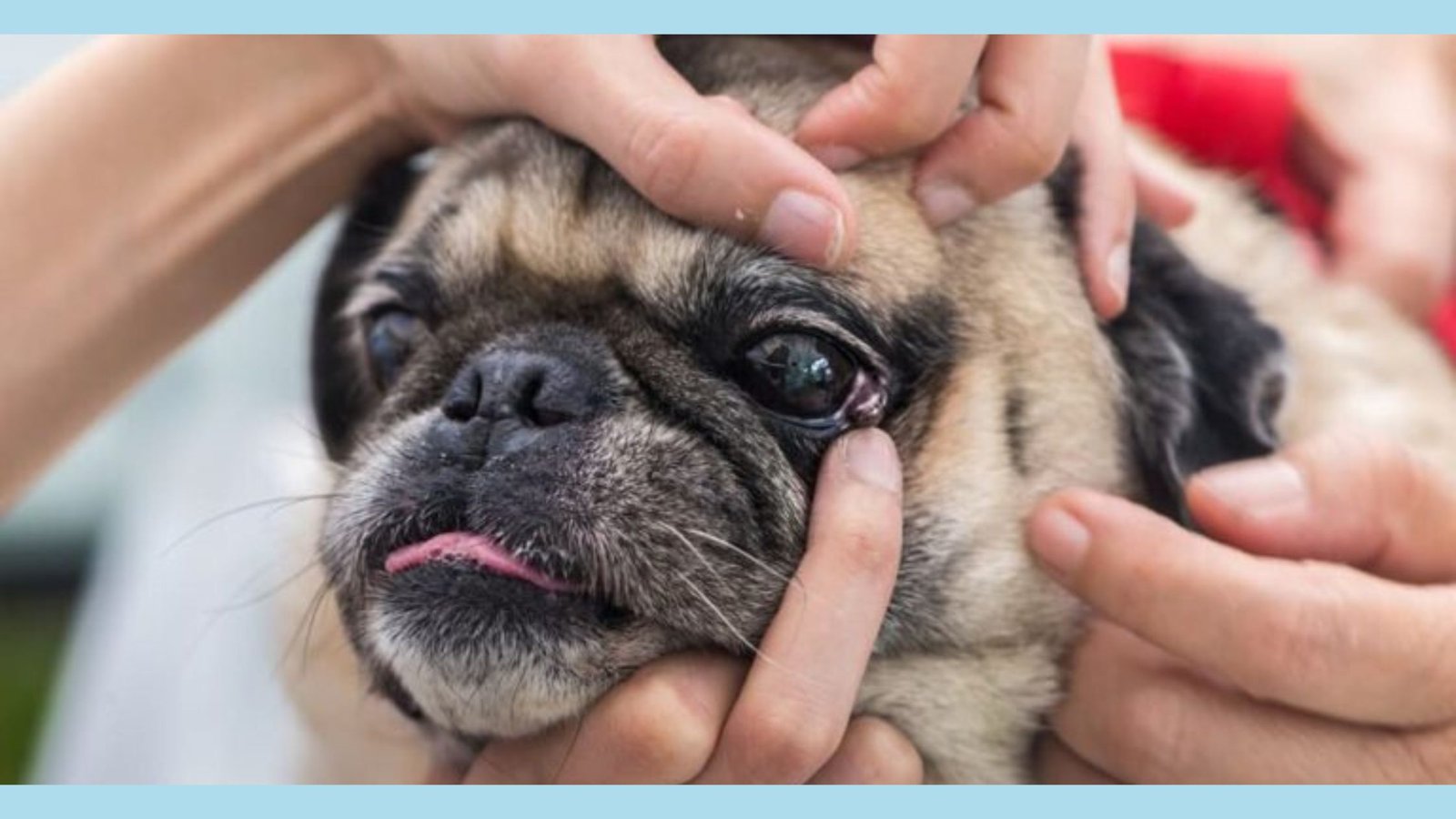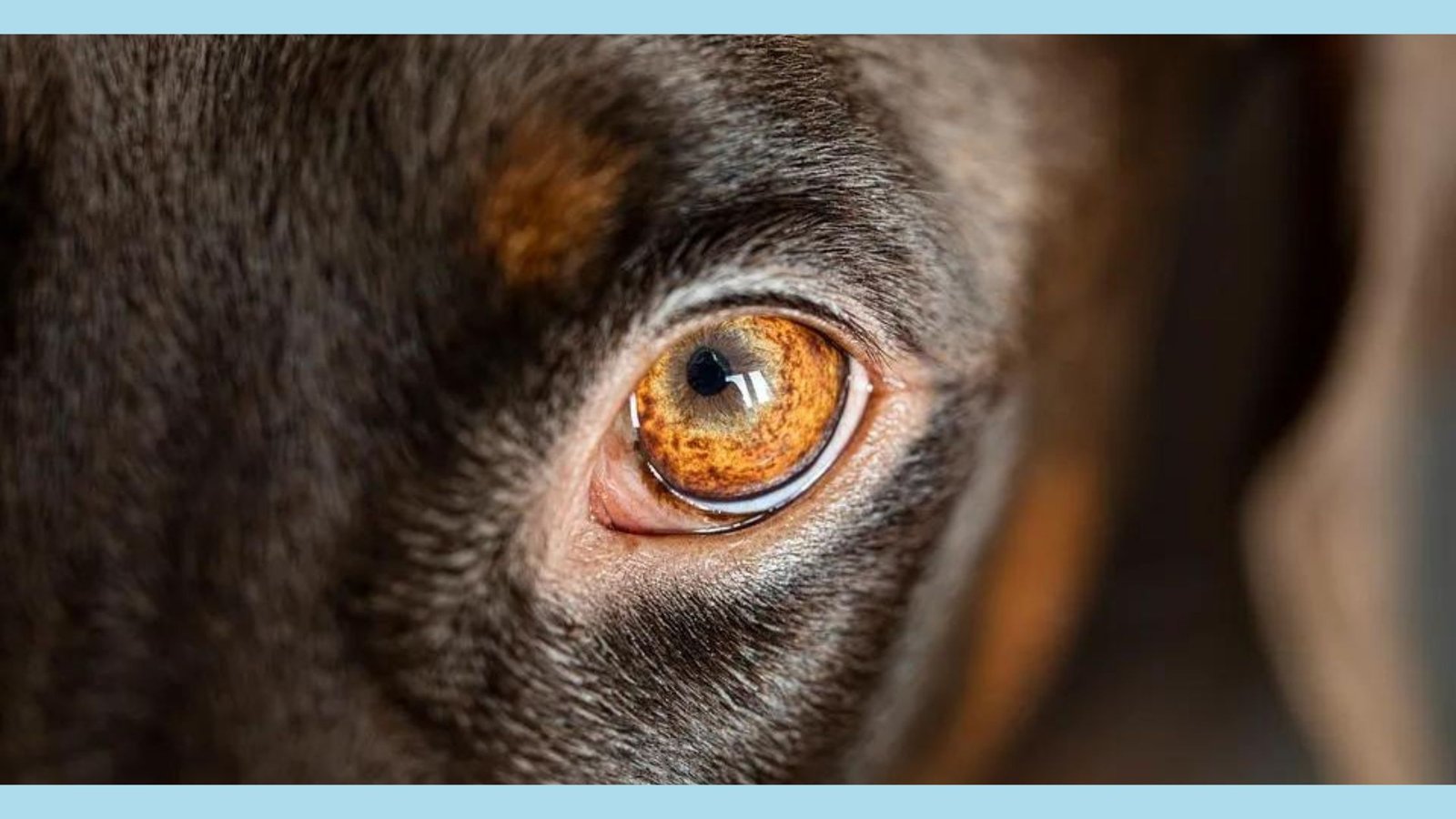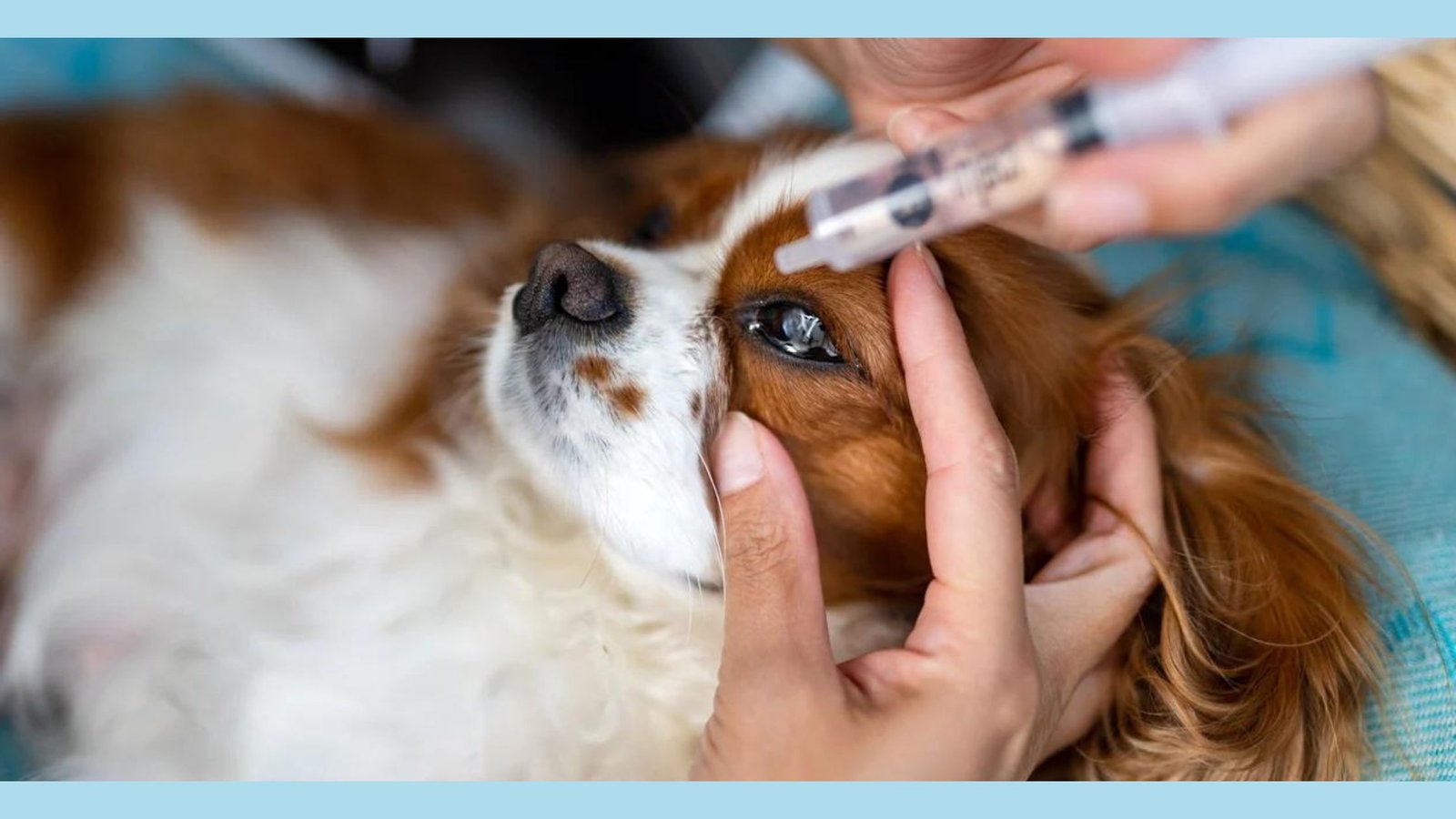
DECODING EYE DISCOMFORTS IN DOGS
When your furry friend’s eyes seem troubled, it’s vital to comprehend the different ailments that could be afflicting their vision. Check what could cause and how to prevent eye infections in dogs!
Varieties Of Eye Infections In Dogs
Conjunctivitis, commonly called “pink eye,” is a frequent culprit. This condition arises when the conjunctiva – the delicate membrane covering the eye’s white area and inner eyelids – becomes inflamed. Bacterial or viral invasions, allergic reactions, or irritants like dust can all trigger conjunctivitis. Reddened eyes, swelling, discharge, excessive tears, and squinting are telltale signs. Neglecting this issue risks severe complications like corneal ulcers or even vision impairment, so prompt veterinary attention is crucial.
Another adversary is keratitis – inflammation of the cornea, the eye’s transparent outer layer. Infections, injuries, or underlying health issues can provoke keratitis. Symptoms include redness, corneal cloudiness, increased tear production, and light sensitivity. Prompt treatment is essential to prevent vision loss.
Occasionally, canines develop uveitis – inflammation of the uvea, the eye’s middle layer. Infections, autoimmune disorders, or eye trauma can instigate this condition. Telltale signs are redness, cloudy eyes, squinting, and pupil size fluctuations. Seeking veterinary care swiftly is imperative for managing uveitis and preserving sight.
Blepharitis: This is an infection of the eyelids, specifically the eyelid margins. It can be caused by bacteria, allergies, or underlying skin conditions. Dogs with blepharitis may experience redness, swelling, and crusting of the eyelids. Treatment typically involves keeping the area clean and using topical medications to reduce inflammation and control infection.

More Unknown Types Of Eye Infections In Dogs
Dacryocystitis: This is an infection of the tear ducts, which are responsible for draining tears from the eyes. It can occur when the tear ducts become blocked or when there is an overgrowth of bacteria. Dogs with dacryocystitis may have watery eyes, discharge, and swelling around the tear ducts. Treatment may involve flushing the tear ducts and prescribing antibiotics to clear the infection.
Corneal ulcer: A corneal ulcer is an open sore on the cornea, usually caused by an injury or infection. It can be quite painful and may lead to vision loss if left untreated. Corneal ulcers in dogs require immediate veterinary attention, as they often require medication, such as antibiotics or anti-inflammatory drugs, to promote healing and prevent further complications.
Retinal infections: Retinal infections, although less common, can occur in dogs. These infections can be caused by bacteria, viruses, or parasites and can result in inflammation and damage to the retina, the light-sensitive tissue at the back of the eye. Retinal infections may cause symptoms such as vision loss, eye pain, and changes in pupil size. Treatment typically involves addressing the underlying infection and managing any associated complications.
Orbital cellulitis: This is an infection of the tissues surrounding the eye. It can be caused by bacteria, fungi, or other pathogens. Dogs with orbital cellulitis may have swelling, pain, and redness around the eye, as well as difficulty opening or closing the eye. Treatment typically involves antibiotics and may also require surgical intervention to drain any abscesses or remove infected tissue.
Viral Infections And Allergies In Dogs
Regardless of the type of eye infection, it is important for dog owners to be vigilant and proactive in recognizing the signs and symptoms. Regularly inspecting your dog’s eyes for any redness, discharge, or changes in behavior can help identify potential infections early on. If you notice any abnormalities, it is crucial to seek veterinary attention promptly to prevent further complications. Treatment for eye infections in dogs will vary depending on the underlying cause. Bacterial infections may require antibiotic eye drops or ointments, while viral infections may be managed with antiviral medications. In cases of allergies or irritants, your veterinarian may recommend using eye drops or washes to alleviate symptoms.
Prevention is also key when it comes to eye infections in dogs. Keeping your dog’s eyes clean and free from debris can help reduce the risk of infections. Additionally, avoiding exposure to potential irritants or allergens can also help prevent certain types of eye infections. So, understanding eye infections in dogs is essential for every dog owner. By being aware of the different types of infections, recognizing the signs and symptoms, and seeking prompt veterinary care, you can help ensure the health and well-being of your furry friend’s eyes.

SYMPTOMS OF EYE INFECTIONS IN DOGS
When a dog has an eye infection, there are several telltale signs that pet owners should be aware of. These symptoms may vary depending on the severity and underlying cause of the infection. Check some common symptoms of eye infections in dogs.
Redness, Inflammation and Discharge
The affected eye may appear red, swollen, and irritated. This can be a result of the dog’s immune system responding to the infection, causing increased blood flow to the area and resulting in redness and inflammation.
There may be a discharge from the eye, which can range from clear and watery to thick and pus-like. The type of discharge can provide valuable information about the type of infection present. Clear and watery discharge may indicate a viral infection, while thick and pus-like discharge may suggest a bacterial infection.
Excessive Tearing and Squinting Or Blinking
The infected eye may produce excessive tears, leading to wetness around the eye area. This can be a result of the eye trying to flush out the infection or a response to the irritation caused by the infection.
Dogs with eye infections often squint or blink frequently due to the discomfort. This is their way of trying to protect the affected eye and alleviate some of the pain or irritation.
Cloudiness Or Opacity and Rubbing Or Pawing At The Eye
In some cases, the infected eye may appear cloudy or opaque. This can be a result of inflammation or the accumulation of pus or debris in the eye. Cloudiness or opacity may also indicate a more severe infection or damage to the eye.
Dogs may try to relieve the discomfort by rubbing or pawing at the affected eye. This can further irritate the eye and potentially cause additional damage. It is important to discourage this behavior and seek veterinary care to address the underlying infection.
It is important for pet owners to be vigilant and monitor their dog’s eye health. If you observe any of these symptoms, it is recommended to seek veterinary attention. Early detection and treatment of eye infections in dogs can help prevent complications and promote a speedy recovery.
Contact Your Veterinarian
If you observe any of these symptoms in your dog, you should know that it’s important to consult with your veterinarian for a proper diagnosis and treatment plan. They will be able to determine the underlying cause of the infection and prescribe appropriate medications or treatments. It is crucial to seek veterinary care as soon as possible, as untreated eye infections can lead to more serious complications, such as corneal ulcers or vision loss.
Additionally, some eye infections may be a sign of an underlying health condition, such as allergies or autoimmune disorders, which require further investigation and management. Your veterinarian will perform a thorough examination of your dog’s eyes, including checking for any foreign objects or injuries, assessing the extent of the infection, and conducting any necessary diagnostic tests.
Proper Diagnosis And Treatment Plan
Based on their findings, they may recommend topical or oral antibiotics, anti-inflammatory medications, or other treatments to alleviate your dog’s symptoms and promote healing. In some cases, they may refer you to a veterinary ophthalmologist for specialized care. It is important to follow your veterinarian’s instructions carefully and complete the full course of treatment to ensure the infection is fully eradicated.
Additionally, you can help prevent future eye infections in your dog by practicing good hygiene, such as regularly cleaning their eyes with a veterinarian-approved eye wash, keeping their face and eye area clean and dry, and avoiding exposure to irritants or allergens that may trigger an infection. By being proactive about your dog’s eye health and seeking prompt veterinary care when needed, you can help keep their eyes bright, healthy, and free from infection.

CAUSES OF EYE INFECTIONS IN DOGS
There are several potential causes of eye infections in dogs. Understanding these causes can help pet owners take preventive measures and seek appropriate treatment when necessary. Check some common causes of eye infections in dogs.
Bacterial Infections, Viral Infections and Allergies
Bacteria, such as Staphylococcus or Streptococcus, can invade the dog’s eye and cause an infection. These bacteria can be present in the environment or can be introduced through contact with other infected animals. Poor hygiene, such as not regularly cleaning the dog’s eyes or allowing them to come into contact with dirty water or soil, can increase the risk of bacterial eye infections.
Viral illnesses like distemper or herpes can prompt nasty eye infections in pups. These pesky viruses spread like wildfire through nose-to-nose contact or contaminated surfaces. Dogs with weaker immune systems sadly have a higher risk of catching a viral eye bug.
Sometimes, a pooch’s own body betrays them. Allergens, whether pollen, dust mites or certain eats, can trigger an overreaction – causing inflamed, irritated peepers. This cozy environment then invites infection-causing bacteria or microbes to move in and make themselves at home.
Foreign Objects, Scratches Or Injuries
Exploring a dog’s natural curiosity can backfire when bits of debris or plant matter get lodged in the eye. Irritation and infection are swift to follow. Owners should vigilantly check those puppy-dog eyes to swiftly remove any uninvited guests.
Eye injuries from rambunctious play, accidents or scuffles with other animals act as an open doorway for bacterial stowaways. Any scratch or wound demands immediate vet care to halt potential complications or infections from settling in.
Conjunctivitis Or Pink Eye
Conjunctivitis, also known as pink eye, can occur in dogs and cause inflammation and infection of the conjunctiva. This condition can be caused by bacteria, viruses, allergens, or irritants. Dogs with conjunctivitis may experience redness, discharge, and discomfort in their eyes. Prompt diagnosis and treatment are essential to alleviate the symptoms and prevent the spread of infection.
By understanding the various causes of eye infections in dogs, pet owners can take proactive steps to protect their furry friends’ eye health. Regular eye examinations, proper hygiene practices, and prompt veterinary care for any eye-related issues can help prevent and manage eye infections in dogs.

PREVENTION OF EYE INFECTIONS IN DOGS
If you suspect that your dog has an eye infection, it is crucial to seek veterinary care for a proper diagnosis and treatment plan. The veterinarian will examine your dog’s eye and may perform additional tests to determine the underlying cause of the infection. Treatment for eye infections in dogs typically involves a combination of medications and supportive care. Depending on the severity and cause of the infection, the veterinarian may prescribe antibiotic or antiviral eye drops or ointments to combat the infection.
How to Prevent Eye Infections In Dogs
In some cases, oral medications or other treatments may be necessary. In addition to medication, there are several steps you can take to prevent eye infections in your dog:
Maintaining your pup’s peepers is a priority for pet parents. Gently swipe around those soulful eyes with a damp cloth to clear away any grime or debris. This step is especially crucial for furry friends rocking luscious locks, as long hair can trap nasty stuff and bacteria near the eyes.
If your canine companion sports a lustrous mane around the eyes, consider a trim to prevent eye irritation or bacteria buildup. Proceed with caution when snipping strands near those sensitive sight orbs. If you’re unsure, consult a pro groomer for expert assistance.
Be wary of exposing your furry pal to potential irritants like smoke, harsh chemicals, or potent fragrances, as these can increase the risk of pesky eye infections. For smokers, light up away from your pup and ensure proper ventilation at home to keep the air fresh.
Prevent eye injuries by steering your canine clear of sharp objects, prickly plants, or situations where they might get scratched or whacked in the eye. During playtime, stick to safe toys and avoid rough-and-tumble games or objects that could cause harm.
Schedule regular check-ins with your trusty vet to ensure your dog’s overall health and catch any potential eye infections early on. During these visits, the vet can inspect your pup’s peepers and provide any necessary preventive care, like vaccines or parasite control.
Accurate Diagnosis By The Vet
It is important to note that the specific treatment for dog eye infections will vary depending on the type and severity of the infection. If you suspect that your dog has an eye infection, it is always best to consult with a veterinarian for an accurate diagnosis and appropriate treatment plan. When it comes to treating dog eye infections, the approach will depend on the underlying cause. In many cases, your veterinarian will prescribe antibiotic or antiviral eye drops or ointments to help clear the infection. They may also recommend cleaning the eye with a saline solution to remove any discharge or debris.
In addition to medication, it is important to provide your dog with a clean and comfortable environment to aid in their recovery. Avoid exposing them to irritants such as dust, smoke, or chemicals, and make sure their bedding and toys are kept clean to prevent further contamination. Regular veterinary check-ups and good hygiene practices can help prevent eye infections in dogs. Keep your dog’s eyes clean by gently wiping them with a damp cloth, and be mindful of any changes in their behavior or appearance of their eyes. By being proactive and seeking prompt veterinary care, you can help ensure your dog’s eyes stay healthy and infection-free.

TREATMENT OPTIONS FOR EYE INFECTIONS IN DOGS
The treatment for eye infections in dogs will depend on the type and severity of the infection. In most cases, your veterinarian will prescribe topical ointments or eye drops to help alleviate the symptoms and clear the infection. These medications may contain antibiotics, antiviral agents, or anti-inflammatory drugs.
Treating Your Dog’s Infected Eye: Antibiotics, Drops, and Cleansing
Your vet may recommend more than just medication to address your pup’s eye infection. Warm compresses can ease inflammation and promote healing. Severe or persistent cases might require additional steps like surgery or systemic meds. Your vet will devise the ideal treatment plan for your dog’s specific condition. Antibiotics are often prescribed if the infection is bacterial to wipe out the growth.
These antibiotics usually come as eye drops or ointments. It’s crucial to follow your vet’s dosage instructions precisely, even if symptoms improve, to prevent recurrence or antibiotic resistance. For viral infections, antiviral eye drops or ointments may be used. While they can’t cure the virus, these meds help suppress viral activity and reduce infection severity. The focus is managing symptoms and avoiding complications.
If inflammation accompanies the infection, your vet may prescribe anti-inflammatory eye drops. These reduce redness, swelling, and discomfort by dampening the immune response and preventing further eye tissue damage. Along with medication, your vet will likely advise regularly cleansing the affected eye. Using sterile saline or a prescribed cleanser, this removes discharge and debris that could worsen or prolong the infection.
Surgical Intervention, Draining Abscesses Or Removing Any Foreign Objects
Applying warm compresses to the affected eye can provide relief and promote healing by increasing blood flow and delivering vital nutrients to the infected area. The soothing warmth helps alleviate inflammation and discomfort. In severe or persistent cases, your vet may recommend surgical intervention. This could involve draining any abscesses or removing any foreign objects causing the infection. Surgery may also be necessary if the infection has spread to other parts of the eye or if complications like corneal ulcers or glaucoma develop.
In situations where the infection has spread beyond the eye or if underlying systemic issues contribute, your dog may be prescribed systemic medications like oral antibiotics or antiviral drugs. These work to eliminate the infection throughout the body and address any compromising factors affecting your dog’s immune system. The treatment options for eye infections in dogs vary and are tailored to each dog’s specific needs. Consulting your veterinarian is crucial to determine the most appropriate course of treatment. With prompt and proper treatment, most eye infections in dogs can be successfully resolved, leading to full recovery and restored eye health.
Preventive Measures For Eye Infections In Dogs
In addition to these preventive measures, it is important to be aware of the common causes of canine eye infections. One of the most common causes is bacteria, which can enter the eyes through various means such as dirt, dust, or contact with other infected animals. Fungal infections can also occur, especially in dogs that spend a lot of time in moist environments or have weakened immune systems. Another cause of eye infections in dogs is viral infections, which can be highly contagious and easily transmitted between dogs.
These viruses can cause symptoms such as redness, discharge, and swelling of the eyes. It is important to keep your dog away from infected animals and to practice good hygiene to prevent the spread of these viruses. Additionally, certain breeds of dogs may be more prone to developing eye infections due to their anatomy. For example, dogs with bulging eyes, such as Pugs or Boston Terriers, are more susceptible to eye injuries and infections. It is important to be extra vigilant in monitoring their eye health and taking preventive measures to reduce the risk of infection.
Lastly, maintaining a healthy lifestyle for your dog can also help prevent eye infections. Providing a balanced diet, regular exercise, and proper grooming can boost your dog’s immune system and overall health, reducing the likelihood of developing infections. By following these preventive measures and being aware of the common causes of eye infections in dogs, you can help keep your furry friend’s eyes healthy and reduce the risk of infections. However, it is always important to consult with a veterinarian if you notice any concerning symptoms or if you have any questions about your dog’s eye health.

Pups can get sore peepers sometimes, so it’s wise to know the scoop! Eye infections often start small but can grow gnarly if left untreated. The experts at the American Kennel Club have heaps of helpful info on spotting signs, causes, and much more!



